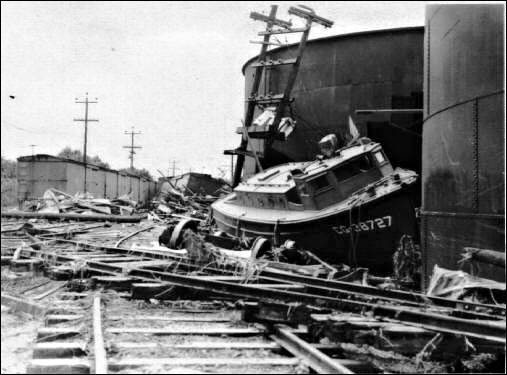The name Kaluakapo Crater or “Kalua Kapo” means “hole of darkness” (according to the field notes of Stearns, 1936; Keating & Helsley).
Three ancient shorelines (the Mahana, Kaluakapo and Manele) have been described at elevations of 365, 190 and 170 m [1,200, 625, and 560 feet] in the Kaluakapo Crater. Original observations/theories of a fossil-bearing outcrop at 1,200-feet was interpreted as an ancient shoreline.
Subsequently, some argued that this fossil evidence represented the highest inundation of tsunami waves associated with the collapse of the flanks of the Hawaiian Islands chain. (Keating & Helsley)
“Geologists have long debated whether the Hawaiian Islands have been periodically hit by ‘megatsunamis,’ triggered by massive landslides plunging into the ocean.”
“Indeed, several such slides have cascaded from the western flanks of the Big Island–including the 350-cubic-kilometer Alika 2 slide about 120,000 years ago.” (Robert Irion)
“Some researchers think that a megatsunami from that slide deposited coral and seashells high on the slopes of the island of Lanai more than 100 kilometers away.”
“Others reject that interpretation, claiming that the deposits mark the level of shorelines carved into Lanai before tectonic processes lifted the island.” (Robert Irion)
“[T]he giant wave hypothesis (GWH) suggests a submarine landslide southeast of Lanai triggered three ‘giant waves’ that rushed toward Lanai with initial velocities of 149 m/s, at intervals of only one and a half minutes.”
“The first wave reached 190 m elevation on Lanai and eroded the soils and churned up boulders. The second wave reached the 375 m elevation, and picked up the gravels in suspension and stripped the terrain.”
“The third wave reached 190 m high on the island slope taking boulders in suspension, then accelerated down slope, stripping soil and molding the boulders into mound-shaped bed forms.” (Keating & Helsley)
“Computer simulations show that the tsunami would have swamped the other islands as well. ‘These waves were truly catastrophic,’ [Geologist Gary McMurtry of the University of Hawai‘i, Mānoa] says.”
“Still, [McMurtry] notes, they would be about as rare as megatsunamis from asteroids hitting the ocean–grave threats, but extremely unlikely in our lifetimes.” (Robert Irion)
Giant tsunamis, generated by submarine landslides in the Hawaiian Islands, have been thought to be responsible for the deposition of chaotic gravels high on the southern coastal slopes of the islands of Lanai and Molokai, Hawai‘i. Investigators used uranium-thorium dating and a study of stratigraphic relationships.
That late investigation showed that deposits were formed by multiple events, separated by considerable periods of time, thus invalidating the main premise of the ‘giant wave’ theory.
Instead, the gravels were probably deposited during interglacial periods (when sea level was relatively high) by typical Hawaiian shoreline processes such as seasonal wave patterns, storm events and possibly ‘normal’ tsunamis, and reached their present height by uplift of Lanai. (Rubin, et al)
While the general consensus seems to be that a megatsunami was not the culprit, there have been other ‘normal’ tsunami that have impacted Lanai and other Islands.
“It was quite a severe earthquake as I remember. Another scary thing that happened on Lanai was a tidal wave during the building of Kaumalapau Harbor.”
“They were building the breakwater and they had a small locomotive that with the tracks ran out to the end so they could carry boulders out to build up the breakwater.”
“And this tidal wave came and later, we went down to see what damage had been done. And the tracks were twisted in knots and the locomotive was on its side. Ever since then, I’ve been very frightened of tidal waves.”
“No one was injured; it was just this damage because no homes were knocked down where the harbor was. (The homes were built on higher ground, so they were not damaged.)”
No one was working at the time … “I believe that tidal wave came during the middle of the night at a time when there was nobody down there.” (Jean Forbes Adams; UH Oral History, Lanai Ranch)




































